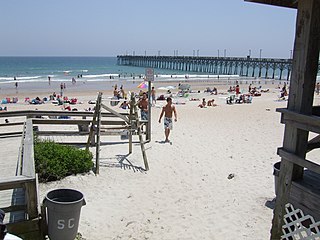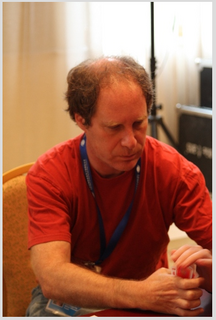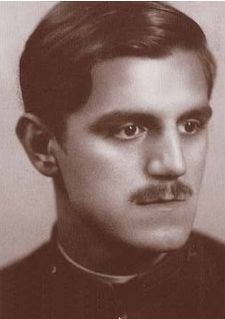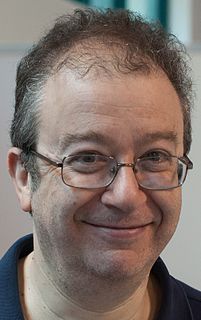Related Research Articles
Charles Henry Goren was an American bridge player and writer who significantly developed and popularized the game. He was the leading American bridge personality in the 1950s and 1960s – or 1940s and 1950s, as "Mr. Bridge" – as Ely Culbertson had been in the 1930s. Culbertson, Goren, and Harold Vanderbilt were the three people named when The Bridge World inaugurated a bridge "hall of fame" in 1964 and they were made founding members of the ACBL Hall of Fame in 1995.

Surf City is a town in Pender and Onslow counties in the U.S. state of North Carolina. The population was 1,853 at the 2010 census. It is located on Topsail Island.

In duplicate bridge, a board is an item of equipment that holds one deal, or one deck of 52 cards distributed in four hands of 13 cards each. The design permits the entire deal of four hands to be passed, carried or stacked securely with the cards hidden from view in four pockets. This is required for duplicate bridge tournaments, where the same deal is played several times and so the composition of each hand must be preserved during and after each play of each deal.
Oswald "Ozzie", "Jake" Jacoby was an American contract bridge player and author, considered one of the greatest bridge players of all time and a key innovator in the game, having helped popularize widely used bidding moves such as Jacoby transfers. He also excelled at, and wrote about, other games including backgammon, gin rummy, canasta, and poker. He was from Brooklyn, New York and later lived in Dallas, Texas. He was the uncle of activist and author Susan Jacoby, as well as father of James Jacoby, an author and world-class bridge player in his own right.
Edgar Kaplan was an American bridge player and one of the principal contributors to the game. His career spanned six decades and covered every aspect of bridge. He was a teacher, author, editor, administrator, champion player, theorist, expert Vugraph commentator, coach/captain and authority on the laws of the game. He was the editor and publisher of The Bridge World magazine for more than 30 years (1967–1997). With Alfred Sheinwold he developed the Kaplan–Sheinwold bidding system. He was from New York City.

The Official Encyclopedia of Bridge (OEB) presents comprehensive information on the card game contract bridge with limited information on related games and on playing cards. It is "official" in reference to the American Contract Bridge League (ACBL) which authorized its production and whose staff prepared and/or supervised its various editions.

Frederick "Fred" Gitelman is a Canadian-American bridge player, developer of bridge software, and a founder of the online bridge platform Bridge Base Online.

Géza Ottlik was a Hungarian writer, translator, mathematician, and bridge theorist. According to an American obituary bridge column, he was known in Hungary as "the ultimate authority on Hungarian prose".

Bridge Base Online (BBO) is the world's largest bridge-playing online platform, with about 10 million monthly visits, as of November 2021. Originally created by professional bridge player Fred Gitelman, BBO was first published by Bridge Base, Inc. in 2001, as a Windows downloadable software, offering free online multiplayer bridge rooms for practice and play. Around 2008, BBO was ported to a web application to also support Linux and macOS users, as well as mobile devices.
Jeremy M. Flint was an English contract bridge writer and one of the world's leading professional players. He was also a horse racing enthusiast. Flint was born in Leeds but lived in London.
Lewis Lawrence Mathe was an American world champion bridge player and administrator from Canoga Park, California.
Lee Hazen was an American attorney, bridge player and baseball player from New York City.
John Gerber was an American bridge player.
Ronald Eugene Andersen was an American bridge player. He won 11 "national"-rated events at North American Bridge Championships, thrice-annual 10-day meets organized by the American Contract Bridge League, where he became known best as a superior live commentator in the vugraph room.
Robert Francis Jordan was an American bridge player. During the 1960s he played on three North America or USA open teams that were runners-up to Italy in world championships. Arthur Robinson was his regular partner was on all three occasions.
Peter Alexander Pender was an American bridge player and figure skater from Forestville, California. He died of AIDS in San Francisco, California.
Peter A. Leventritt was an American bridge player, president of the American Contract Bridge League (ACBL) for 1945–1946. Leventritt was from New York City.
Bridge-O-Rama was a system of electro-mechanical display boards on which an audience could view a representation of the bidding and play of hands at high-level contract bridge tournaments. Developed in Italy and first used in the World Championships at the Bermuda Bowl in 1958, representations of the actual playing cards in each hand were arranged in frames on the display and were able to be lit from behind as play progressed. The lighting was operated by a number of switches at a control console wired to the displays.

Barry Rigal is a bridge player, author, commentator and journalist. Born in England, he was married to world champion Sue Picus and lives in New York.
References
- 1 2 Francis, Henry G.; Truscott, Alan F.; Francis, Dorthy A., eds. (2001). The Official Encyclopedia of Bridge (6th ed.). Memphis, TN: American Contract Bridge League. p. 567. ISBN 0-943855-44-6. OCLC 49606900.
- ↑ Morehead, Albert H. (August 6, 1959). "Contract Bridge; Decision to Sacrifice or Not Calls for Careful Thinking in Tournaments". The New York Times. p. 24.